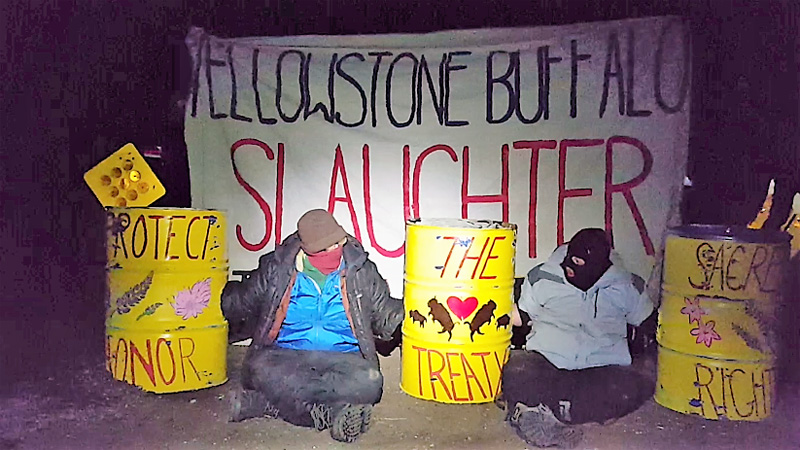
by Deep Green Resistance News Service | Mar 24, 2018 | Biodiversity & Habitat Destruction
Featured image: Coyote and Wolf block the access road to Yellowstone’s Stephens Creek buffalo trap, in an attempt to halt trucks from transporting wild buffalo to slaughter. Photo by Wild Buffalo Defense.
by Stephany Seay / Buffalo Field Campaign
Direct Action
Last Friday, two more people were arrested after attempting to halt Yellowstone from shipping wild buffalo to slaughter. The two men, Coyote and Wolf, with the direct action collective Wild Buffalo Defense, locked down to three concrete-filled barrels in front of the gate to the access road that leads to the trap. They were released from jail on Monday. Their brave act stalled operations for four hours.
Despite these courageous actions along with overwhelming public opposition to the slaughter, Yellowstone continues to kill buffalo. That morning, Yellowstone officials were so determined to send buffalo to slaughter — the very gentle giants the country has entrusted with their care — that they destroyed sensitive habitat to create a road around the blockade so that the trucks could get through.
This begs the question: whom does Yellowstone serve? Certainly not the global public, including Montanans, who are largely opposed to the slaughter of the last wild buffalo. Yellowstone presses on with urgency, capturing and killing as many buffalo as they can so they can make the cattle lobby of Montana happy. Yellowstone betrays Native buffalo cultures, the general public, their mission, the Organic Act, and, most importantly, the buffalo. Not even in Yellowstone National Park is our national mammal safe.
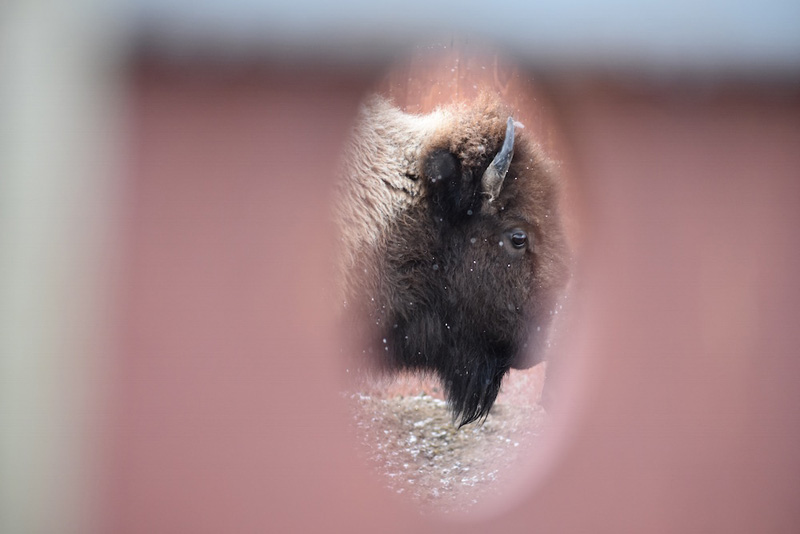
An adult female buffalo held captive inside Yellowstone’s trap. She’s imprisoned in a small, dung-filled sorting pen until such time as trucks and trailers arrive to send her and her friends to slaughter. Photo by Stephany Seay, Buffalo Field Campaign.
Perhaps in response to the embarrassment they feel from doing what they know is wrong, and to having their “government operations” interrupted again, Yellowstone treated the two men very aggressively and made shocking statements in defense of the slaughter, telling the protectors, “these buffalo are going to die and there’s nothing you can do to stop it!”
Yellowstone Captures More Buffalo, Far Exceeds Kill Quota
Yellowstone has further retaliated by capturing more buffalo, bringing the total captured to nearly 800 individuals. Even though it’s just a few weeks away from calving season, they still may not be done. Many of these buffalo are from the imperiled Central herd, who even Yellowstone admits are in dire straights. The buffalo managers (read: manglers) that entered this winter with a goal of killing between 600-900 buffalo have far exceeded this quota.
Given the number of buffalo captured for slaughter and quarantine, along with the excessive hunting that took place along Yellowstone’s boundary, more than 1,200 buffalo have been eliminated from the country’s last wild, migratory buffalo populations, which now hovers at fewer than 3,600. That doesn’t even include natural winter mortality, which can also take a heavy toll.
It is unknown how many remain in the Central herd, who numbered a shocking 847 before this killing season began. Over 100 were killed by hunters in the Hebgen Basin, and aside from a few radio-collared females, none of the bison managers know how many of the buffalo killed in the Gardiner Basin were from this highly endangered population. Yellowstone is acting in foolish haste to appease Montana’s livestock industry, making excuses not backed by science, ecology, or public sentiment to wantonly destroy this sacred, keystone species, who is a national treasure and the last of their kind.
Yellowstone’s buffalo slaughter continues to be challenged from every direction, and pressure on them is increasing and will continue to do so until they quit being puppets for Montana cowboys.
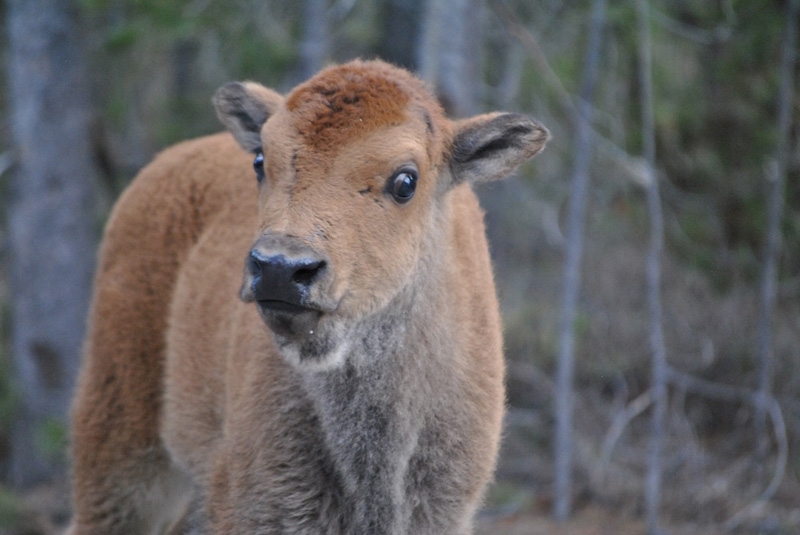
There is hope in the coming of the calves. Photo by Stephany Seay, Buffalo Field Campaign.
Hunting Has Ended
Hunting seasons have finally ended, so some buffalo are enjoying a respite. Of the buffalo who do roam free, BFC Gardiner patrols report that fewer and fewer are in the Gardiner Basin. Spring is here, and calving season will be underway in just a few weeks. Buffalo are starting to move to their calving grounds; Northern herd buffalo are heading up towards the Blacktail Plateau, while the surviving Central herd buffalo are slowly beginning to move into the Hebgen Basin.
There is hope in the coming of the calves. Grizzly bears are also waking up. Patrols cut fresh tracks of a young grizzly the other morning, and there has been another sighting around Horse Butte, and a couple inside the park. These bears are hungry and are looking for winter-killed buffalo meat — an extremely important food source for them after emerging from their long winter’s nap. We hope they will find enough food to eat, given that Yellowstone has stolen so much of it from them.
Patrols in the Hebgen Basin are making ready to serve as buffalo crossing guards, helping to warn traffic as buffalo migrate to their calving grounds. These rove patrols have saved many lives, both human and buffalo. Our night roves are particularly important, as that’s when buffalo tend to get struck by vehicles, because they are so difficult to see at night.
Patrols are also keeping a close eye south of the Madison River, where buffalo were not granted year-round habitat, and are therefore threatened by hazing operations conducted by the Montana Department of Livestock. But, thanks to the incredible victory of gaining wild buffalo year-round habitat on Horse Butte and lands north, we are also very much looking forward to the days we can just be on the land with the buffalo, watching the new calves arrive, spending time in their peaceful presence, listening to their stories.
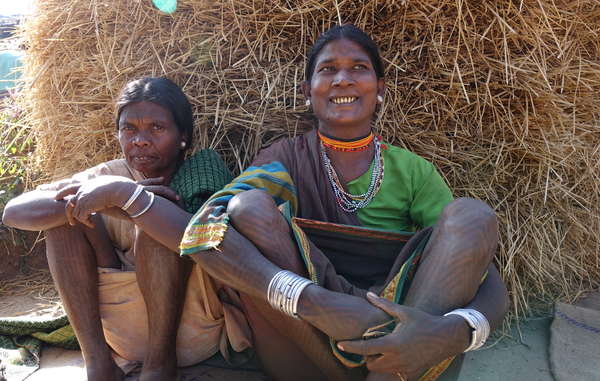
by Deep Green Resistance News Service | Mar 15, 2018 | Colonialism & Conquest
Featured image: Baiga women threatened with illegal eviction, Achanakmar Tiger Reserve. The villagers are determined to stay and say they don’t want to leave their forest home. © Survival International
by Survival International
Hundreds of Baiga people from the area that inspired Kipling’s The Jungle Book are rallying to oppose the authorities’ attempts to evict them from the forests that they have lived in and managed since time immemorial.
Baiga tribespeople are joining forces from over 70 different villages in an area of 1,500 square kilometres. The protests have been sparked by official efforts to evict two Baiga communities from a wildlife “corridor.” Dozens of neighboring Baiga communities are now terrified they will be next, as they face poverty, exploitation and misery if forced from their homes.
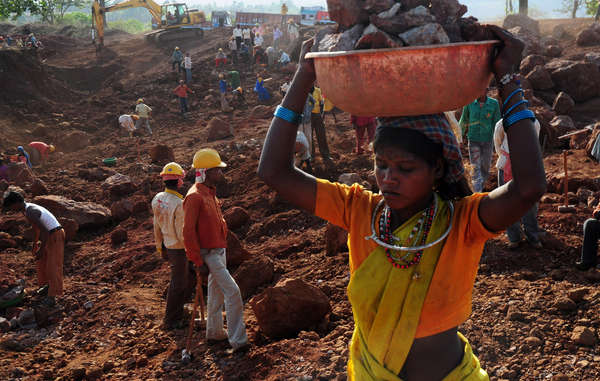
The fate that could await many Baiga threatened with illegal eviction: a Baiga woman works for a pittance in a bauxite mine. © Sayantan Bera/Survival
The Baiga are particularly worried by the two upcoming evictions, as both state authorities and the World Wildlife Fund (WWF) promised that evictions would not take place in the “corridor” areas, which run between the protected nature reserves.
By law, any resettlements of tribal people must be voluntary, even for those living in designated conservation areas. However Baiga people report threats, intimidation and violence until they have no choice but to leave their homes.
Baiga elder, Bhardan Singh told Survival International: “The forest guards beat me until I fell from the tree. I split my hip bone and couldn’t stand. I crawled to the edge of the park. The guards just left me and walked away.”
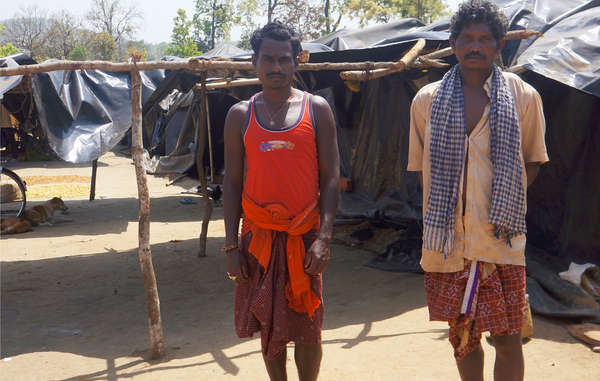
These Khadia tribespeople were evicted from a tiger reserve and forced to live for months under plastic sheets. Promises of “compensation” are rarely fulfilled. © Survival
This weekend’s protest is a local flashpoint in an ongoing national issue. Tribal peoples living in tiger reserves across India are being forced to leave their ancestral homelands in the name of tiger conservation. However, tiger numbers have increased rapidly in the first reserve in India where a tribe won the right to stay on their land, showing people and tigers can flourish alongside one another.
Survival International, the global movement for tribal peoples’ rights, launched a tourist boycott in November last year, urging visitors to India not to visit any of India’s tiger reserves until the Indian tiger authority respects tribal peoples’ rights to live in and protect their forests.
Survival Director Stephen Corry said: “These evictions, both inside and outside the tiger reserves, are totally unjustified, as well as illegal. Not only do they destroy the lives of the people forced from their homes, but they don’t help the tigers either. The authorities and WWF promised there would be no evictions – as so often in the past, such promises have proven worthless.”
Background briefing
– Baiga means “medicine man.” Baiga people are known for their distinctive tattoos, and for their very close relationship to their environment.
– Tribal people were evicted from Similipal tiger reserve in 2013, and were soon after found living in dire conditions under plastic sheets.
– Many Baiga were evicted from the nearby Kanha tiger reserve in 2014. They received no land, houses, or support but were supposed to find land to buy with their compensation money, an alien concept for those who’d lived all their lives in the forest. They told Survival: “We got some money, but we are lost – wandering in search of land. Here there is only sadness. We need the jungle.”
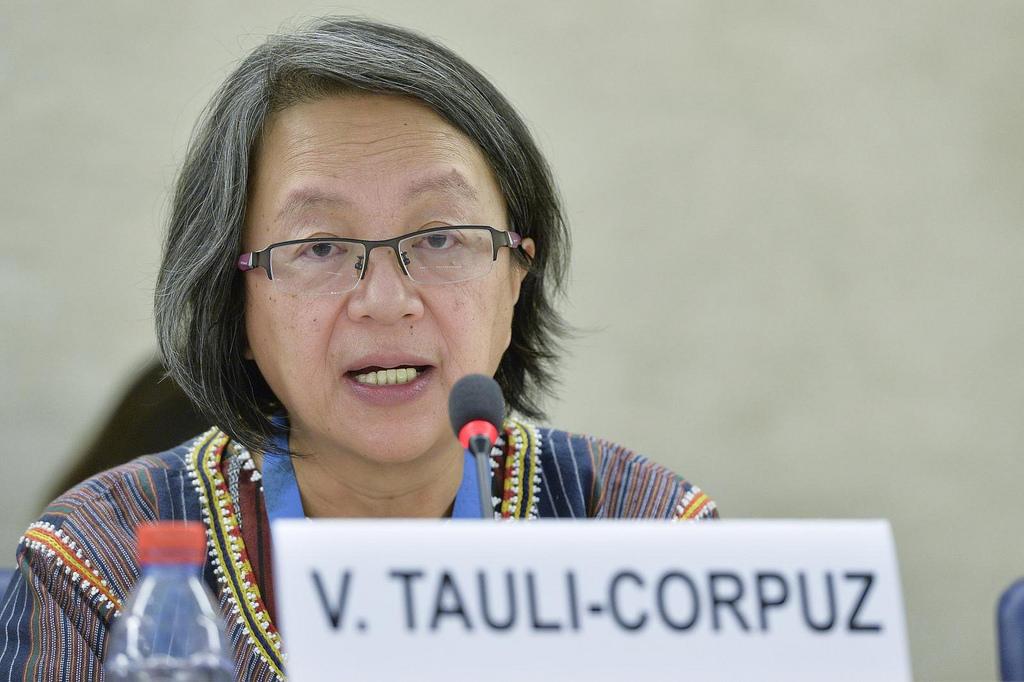
by Deep Green Resistance News Service | Mar 12, 2018 | Repression at Home
by Terri Hansen / Cultural Survival
What do you do when a country places a United Nations Special Rapporteur on a terrorist hit list?
If you’re the UN, you hit back.
A petition filed February 21 in a Manila court by apparently unstable President Rodrigo Duterte of the Philippines labels Victoria Tauli-Corpuz, UN Special Rapporteur on the Rights of Indigenous Peoples ‘a terrorist.’
Human Rights Watch saw the petition this week and called it “a virtual hit list.”
The legal petition accuses 600 people including Victoria Tauli-Corpuz and Joan Carling, co-convener of the Indigenous Peoples Major Group on Sustainable Development, and several other Indigenous human rights defenders as being affiliated with “terrorist and outlawed organizations, associations and/or group of persons” connected to the Communist Party of the Philippines (CPP) and the New People’s Army (NPA).
“There’s a long history in the Philippines of the state security forces and pro-government militias assassinating people labelled as NPA members or supporters,” Human Rights Watch Philippines researcher Carlos Condehe said.
“These attacks cannot go unanswered. The U.N. Human Rights Council must take a position,” UN human rights chief Zeid Ra’ad Al Hussein told news reporters on Friday. “This sort of comment really is unacceptable, unacceptable.”
Although Zeid bluntly stated the president of the Philippines “is in need of a psychiatric evaluation,” there are serious concerns for their safety.
Tauli-Corpuz, a member of the Kankanaey Igorot people in the Philippines, believes she was targeted for statements she made on December 27, 2017 to the Human Rights Council. The Council has entrusted her to provide reports of alleged violations of Indigenous people’s rights worldwide.
Tauli-Corpuz called the allegations, “baseless, malicious and irresponsible,” and added she was consulting with lawyers on legal courses of action to clear her name and make accountable “those who put my life and security at risk.”
Human rights organizations have charged the Philippines army with harassing and killing the Indigenous Lumad people on Mindanao Island who have been caught in the middle of a communist insurgency. The terrorist list is the most recent move by the Philippines in a long conflict between defenders of Indigenous Peoples’ rights and the Duterte administration, the International Work Group for Indigenous Affairs (IWGIA) says.
Under Duterte’s administration, Philippine Indigenous Peoples’ organizations have recorded at least 62 illegal arrests, 21 political prisoners, 20 incidents of forced evacuation affecting 21,966 Indigenous Peoples and more than a hundred others facing trumped-up charges and forcible closure of 34 Lumad schools from July 2016 to December 2017.
“The Government of the Philippines regularly and increasingly threatens and harasses Indigenous Peoples,” Julie Koch, executive director of IWGIA said in a statement. “We are extremely worried about finding some of our long-term partners on the list. We fear for their personal safety.”
One of IWGIA’s partners on the list is Cordillera Peoples Alliance, with co-founder Joan Carling and several other members named. Carling said she expects to take legal action, and as well expects the Philippine government to “ensure the physical safety of those of us who are listed in the petition, as called for by UN experts.”
Targeting Tauli-Corpuz provoked outrage among her fellow rapporteurs.
“We are shocked that the Special Rapporteur is being targeted because of her work defending the rights of Indigenous Peoples,” said Michel Forst, Special Rapporteur on the situation of human rights defenders, and Catalina Devandas Aguilar, chair of the Coordination Committee of the Special Procedures.
The international human rights and Indigenous community is expressing solidarity with Tauli-Corpuz and Carling, while condemning the Philippine government.
“Vicky is an ardent advocate for Indigenous rights around the world, not a terrorist,” Amazon Watch executive director Leila Salazar-López told Cultural Survival. She said the accusations against her were very worrisome. “We will stand with her as she has stood with Indigenous Peoples and land defenders for decades.”
Patricia Gualinga, Kichwa women’s leader from the community of Sarayaku, Ecuadorian Amazon told Cultural Survival, “I stand in solidarity with my sister Vicky.”
“When a woman is clear in her defense of women’s and Indigenous Peoples’ rights, authoritarian governments use their power to criminalize, threaten, and persecute us through the law, as has happened here in the Amazon,” she said.
The growing list of those expressing solidarity with Tauli-Corpuz and Carling include the Cordillera Peoples Alliance, the Cultural Conservancy, the Seventh Generation Fund for Indigenous Peoples, Tero Mustonen of Snowchange in Finland, Tebtebba, Indigenous Climate Action Network, Luisa Maffi of Terralingua, Tarcilla Rivera Zea and Jesús Fuentes as members of United Nations Permanent Forum on Indigenous Issues, and a growing list of others as they learn the news.
The Editorial Director at ČálliidLágádus – ForfatternesForlag said, “I am horrified that human rights defenders like UN Special Rrapporteur for Indigenous Peoples Human Rights are being targeted like this. Vicky is being accused for terrorism by Filipino authorities. This brave, warm-hearted, clear-spoken woman is a defender of humanity, no terrorist!”
Tauli-Corpuz is one of the Indigenous leaders who helped draft the Declaration on the Rights of Indigenous Peoples in 1993 and then lobbied for it for more than 20 years until the UN General Assembly finally adopted the treaty in 2007.
She has founded and managed various nonprofits that raise awareness about social ills, climate change, and the advancement of Indigenous Peoples’ and women’s rights. In 1996, she founded Tebtebba, an international organization that promotes Indigenous Peoples’ perspectives on key issues such as human rights, sustainable development, climate change, and the environment.
Related: Cultural Survival Stands in Solidarity with Victoria Tauli-Corpuz and Joan Carling in the Wake of Unfounded Terrorist Accusations
— Terri Hansen is a member of the Winnebago Tribe. She has covered Indigenous Peoples’ issues since 1993. Hansen’s focus is science and the environment. She has reported on climate change in tribal communities since 2008, and on Indigenous participation in the annual UN climate summits since the COP15 in Copenhagen in 2009. Follow her on Twitter @TerriHansen.

by Deep Green Resistance News Service | Mar 10, 2018 | Women & Radical Feminism
Featured image: The International Coalition Against Human Trafficking
by Max Wilbert / Deep Green Resistance
“Feminism is the struggle to end sexist oppression. Therefore, it is necessarily a struggle to eradicate the ideology of domination that permeates Western culture on various levels, as well as a commitment to reorganizing society so that the self-development of people can take precedence over imperialism, economic expansion, and material desires.” – bell hooks
Last weekend, I was tabling for Deep Green Resistance at an environmental conference. A young man, who looked to be in his early 20’s, came up to the table. I approached him and asked if I could answer any questions.
He pointed at the sticker on the table: “Patriarchy + Capitalism = Pornography.” With a sneer he asked, “Do you really believe that?”
I told him I did. “So are you a SWERF,” he asked, using a common acronym for sex-worker exclusionary radical feminist. “What about agency?”
What an insane thing for a leftist to ask! Would anyone say that I’m “denying the agency of U.S. soldiers” because I oppose US imperialism? Would anyone say that I’m “excluding McDonald’s workers” because I oppose capitalism and the fast food industry?
Of course not. These arguments are self-evidently bullshit. It’s possible (and I can’t believe I have to say this) to oppose larger systems while still having sympathy, and even acting in solidarity, with those who are trapped inside those systems. And just because some women “choose” and “enjoy” working in pornography and prostitution doesn’t mean that we can’t critique the industry—and even critique these women for choices that have harmful effects on others.
The fact that a member of an oppressed class chooses to participate in the oppressive system doesn’t mean their choice can’t be criticized. After all, as the wonderful anti-porn activist Gail Dines has said, “Systems of oppression are flexible enough to absorb some members of subordinated groups; indeed, they draw strength from the illusion of neutrality provided by these exceptions.”
So why does this young white man believe that when it comes to pornography, “agency” is more important than the real, material impacts of the porn industry?
What I explained to the young man is that mass media and culture shapes the way we think. This has been a fundamental understanding of the left for decades. We can call it manufacturing consent, propaganda, or cultural hegemony.
Advertising works. Propaganda works. That’s why they use it.
That’s why Arundhati Roy, writing about right-wing police forces battling indigenous land defenders in rural India, quotes the superintendent of police chief as saying, “See Ma’am, frankly speaking this problem [sic] can’t be solved by us police or military. The problem with these tribals is they don’t understand greed. Unless they become greedy there’s no hope for us. I have told my boss: remove the force and instead put a TV in every home. Everything will be automatically sorted out.”
Take the same approach and apply it to patriarchy, and you’ll have the last 50 years of this culture: pornography becoming more and more normalized, softcore porn moving into pop culture and social media, and ubiquitous access to demeaning, woman-hating content 24/7 from the device in your pocket.
The pornography industry in the United States is more profitable than Hollywood. It’s also more profitable than the NFL, NBA, and MLB—combined. Porn sites, at any given time, have about 30 million unique visitors watching.
As Sheila Jeffries writes, “Pornography, then, educates the male public. It would be very surprising if it did not.”
Do you really think that getting paid a small amount of money in order to have a strange, smelly man aggressively fuck you is “empowering?”
Here’s the reality: prostituted women are often “physically revolted and hurt by the sex.”
Women who have escaped prostitution have higher rates of PTSD than soldiers who have been in combat.
Read that sentence again.
There are an estimated 40 million people in prostitution worldwide, most of them (more than 80 percent) women and children. Women of color make up a highly disproportionate number of prostituted women. Of the 40 million, 2.5 million are trafficked. In other words, they are sex slaves. The average age of entry to the industry is 13 years old.
Thirteen fucking years old.
But in the face of this violence, the “agency” of a few relatively wealthy “sex workers” who claim to enjoy their jobs is more important.
If we call prostitution a “job” (rather than a form of abuse), it would be by far the most dangerous job in the US, with a murder rate of 204 per 100,000. Even if we don’t call every sex act within the context of prostitution a rape, about 80 percent of prostituted women have been raped, and they are raped an average of 8-10 times per year.
As indigenous feminist Cherry Smiley writes (brilliantly) in the Globe and Mail, “Prostitution, akin to the residential school system, is an institution that continues to have devastating impacts on the lives of aboriginal women and girls, who are disproportionately involved in street-level prostitution. Prostitution is an industry that relies on disparities in power to exist. We can see clearly that women, and especially aboriginal women and girls, are funneled into prostitution as a result of systemic inequalities such as their lack of access to housing, loss of land, culture, and languages, poverty, high rates of male violence, involvement with the foster care system, suicide, criminalization, addiction, and disability. To imagine that prostitution, a system that feeds these inequalities, should be allowed or encouraged, is dangerously misguided and supports the ongoing systemic harms against our women and girls.”
The whole notion of a SWERF is ridiculous. As Jindi Mehat writes, “Supporting an argument that excludes the majority of women in prostitution, while calling the very women who consider the whole picture ‘exclusionary,’ shows how intellectually vapid and hypocritical so-called liberal feminism is. Just like calling support of prostitution, which exposes the most marginalized among us to increased levels of violence and abuse, a feminist position, this isn’t about women’s liberation, it’s about feeling good and progressive and not having to actually change anything…
“Supporting prostitution and screaming ‘SWERF’ at abolitionists isn’t feminism, it’s capitulating to male supremacy and writing marginalized women off as collateral damage. It’s living in a dream world of consequence-free individual choices. It’s refusing to go beyond scratching the surface, and instead hiding behind buzzwords and tepid half-measures while trying to silence women who are willing to dive deep no matter the cost.”
So what do we actually want?
Radical feminists generally advocate for what is called “The Nordic Model,” a legal approach in which the people (almost entirely men) who buy sex are criminalized, and the people (almost entirely women and children) who work in the industry are provided with resources and programs to help them exit the sex trade and build alternative livelihoods.
This approach has been proven to result in positive outcomes. First, it teaches sex buyers (“johns”), who are primarily men, and the broader society, that women are not for sale at any price. Second, it provides support and full decriminalization to those who are prostituted, giving them options to exit the inherently-violent industry.
In my book, that’s not exclusionary, that’s human rights. That’s feminism.
To repost this or other DGR original writings, please contact newsservice@deepgreenresistance.org
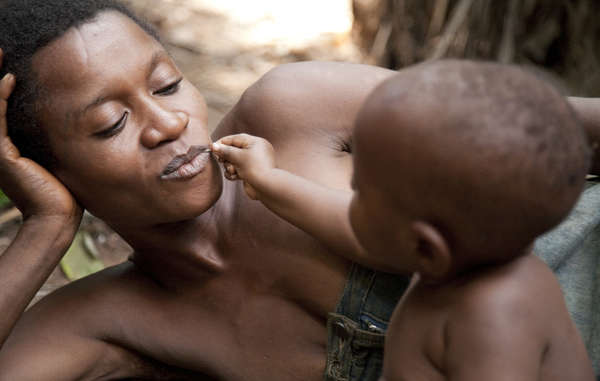
by Deep Green Resistance News Service | Mar 9, 2018 | Colonialism & Conquest
Featured image: The Baka are better at looking after their environment than anyone else. © Selcen Kucukustel/Atlas
by Survival International
Four Baka – two women and two men – were beaten up by eco-guards in the Republic of Congo last week. The Baka had just returned to their village, after spending the day in the forest, when a squad of eco-guards arrived and accused them of hunting elephants.
Survival has received reports that the two Baka men were arrested and are now in prison, even though the eco-guards found no evidence that they had been hunting.
A similar case of abuse was reported in a neighbouring community a week earlier, around 23 February: a group of Baka were coming out from the forest when eco-guards beat them up and arrested them.
Eco-guards are patrolling huge swathes of north-east Congo Republic, including regions which are not officially recognized as “protected” areas. They are funded and equipped by WWF and according to several sources, are spreading terror among Baka in the name of conservation.
A Baka man told Survival: “They always do that kind of abuse, especially to Baka. They need to beat people to show they are doing a good job.”
Eco-guards are also involved in other cases of abuse, harassment, torture and arrest of innocent Baka people. One case, in early 2017, was described as a “catastrophe.” The guards made Baka men, women and children strip to their waists, get to the ground and “crawl like snakes” while the guards kicked and whipped them with their belts.
Physical violence is just one part of the abuse that tribal people have to face in the name of conservation. Eco-guards regularly steal Baka food, burn their homes and destroy their tools.
“The eco-guards came here to abuse us for nothing. Every time it is beatings and whippings–and they break our radios, and pierce our cooking pots,” says one Baka man.
Today the Baka say they do not feel free to move around and live in their ancestral land. The climate of fear is so strong that they feel unable to hunt, fish and gather plants to feed their families, with serious consequences for the Baka’s health and well-being.
These abuses are not just illegal: they are harming conservation. Targeting tribal hunters diverts action away from tackling the true poachers–criminals conspiring with corrupt officials–and harms conservation.
Moreover, the big conservation organizations are partnering with industry and tourism and destroying the environment’s best allies. Like many tribal peoples, the Baka know better than anyone else how to take care of elephants and other wildlife in their forests.









